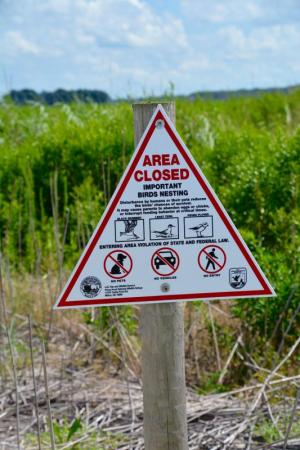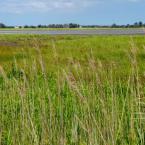In a period of three years, Fowler Beach in Prime Hook National Wildlife Refuge has gone from a thin strip of eroding sand to one of the top five restored beaches in the country.
In the same time period, thousands of acres of destroyed marshland are showing signs of rebirth.
The new growth is the result of a $38 million beach and marsh restoration project to repair beach and marsh devastated by a series of storms over a 10-year period.
“What we have now is a self-sustaining system that is working by trapping sand on the beach and sediment in the marshes,” said refuge biologist Annabella Larsen.
“We hope we can keep pace with sea-level rise, and we think we can,” said Al Rizzo, Coastal Delaware National Wildlife Refuge Complex project manager.
Plants and wildlife are returning to rejuvenated habitats. Among the success stories on Fowler Beach is the establishment of piper plovers, nesting birds that appeared for the first time three years ago, just after beach replenishment. The coarse sand pumped onto the beach from the bottom of Delaware Bay provides a perfect nesting area for the endangered birds.
Horseshoe crabs are returning to the beach in record numbers as well.
During a recent airboat ride, refuge staff spotted osprey, great blue herons, great egrets, egrets, Canada geese, seagulls and various species of terns.
Among the plants now growing in the marsh are cattails, millet, nutmeg, spartina, meadow grass, swamp reed, water hemp, cardinal flowers, marsh mallows and swamp roses, to name a few.
The fishery is improving with the return of river herring, American eel and hickory shad, Rizzo said.
Other changes are taking place. Even with the dry conditions over the summer months, there have been no algae blooms. “In previous years, we had nothing but blooms,” Rizzo said.
Different habitats in Units 2, 3
The refuge is divided into four impoundments called units. Unit 2 and Unit 3, where the vast majority of damage occurred, are developing into different habitats.
Larsen said lower salinity in Unit 3 accounts for greater plant diversity. She said sprangletop, an annual grass about 3 feet tall, is now the dominant plant. It flowers in September, producing a flat seed that is sought after by waterfowl, shorebirds and other marsh birds. Other plants growing this year include cattails, bulrush, nutsedges, smartweeds, marsh mallow, barnyard grass, foxtail, cordgrass and phragmites.
In contrast, she said, Unit 2 is developing into a typical tidal marsh habitat with a different dominant plant. Saltmarsh cordgrass is a perennial grass 1 to 8 feet tall. Its seeds are food for black ducks and shorebirds, and the root stalk is important for geese and muskrats.
The tight roots of the cordgrass are key in controlling coastal erosion, mitigating storm damage and flooding as well as purifying water passing through wetlands, Larsen said.
The majority of the plants are from natural colonization, Rizzo said. The project included the planting of 200,000 spartina grass plugs and some crop-duster applied seed collected from native sources, Rizzo said.
Piping plovers in record numbers
The endangered piping plover has found a new home at restored Fowler Beach. Stormy Vandeplas, a plover technician, said 12 pairs of plovers have established nests and hatched 44 chicks. So far, she said, 29 chicks have fledged, a state record.
Last year, seven pairs nested, and 12 plovers fledged; in 2016, there was one nest, the first ever at the refuge.
Vandeplas heads a small team dedicated to monitoring the plovers. The nests are protected from predators – mainly red foxes – with screened enclosures.
Vandeplas said she hopes to be able to band some of the plovers next year.
Fowler Beach had been closed to the public since mid-April, reopening Sept. 1.
The last quarter-mile section of Fowler Beach Road leading to the beach has been removed and replaced with a walking trail. A small parking area, which provides access for kayak and canoe launching as well as crabbing and fishing, has been enlarged and refuge officials say an observation deck is on the drawing board.
As Mother Nature works to restore the marsh, Rizzo said officials can turn to other areas of the refuge management plan, including a plan to establish more upland wooded areas.
In addition, refuge staff are monitoring the hydrology, vegetation growth, fish species, beach shoreline, nesting birds on the beach, sediment and invasive species to help make informed management decisions, Rizzo said.
“We don't have the exact same mission as a federal or state park,” Rizzo said. “People tend to forget that a wildlife refuge's top priority is habitat for wildlife, and that guides every decision.”
Part I: Birth occurring in Prime Hook Refuge marshes





























































